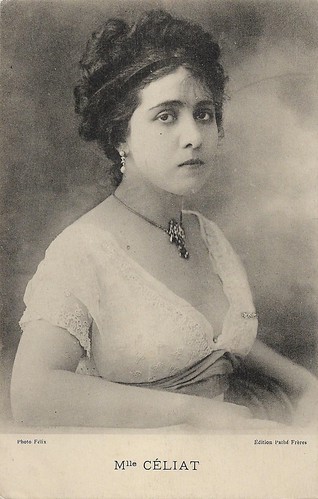
French postcard by Edition Pathé Frères. Photo: Félix.

French postcard by Edition Pathé Frères. Photo: Félix.
Detective Nick Winter
One of the first films of Madeleine Céliat was La Défaite de Satan/The Defeat of Satan (Georges Denola, 1909). She then played in historical films by Pathé Frères like Messaline/Messalina (Henri Andréani, 1910) opposite Paul Capellani, and in one film by Eclair: La fin de Don Juan/Don Juan's Death (Victorine-Hippolyte Jasset, 1912), in which she played Donna Anna.
In 1912 Charles Pathé sent her to its Italian subsidiary Film d'Arte Italiana, in order to replace Francesca Bertini who had just left for the Celio company.
In Rome, Céliat was the lead in a half dozen films, among which the first was Stellina, pescatrice di Venezia/The Fisher Girl of Venice (1912) which was shot in Venice in Pathécolor. The film was found back in the 1990s and was restored and presented at the Cinema Ritrovato festival in Bologna.
In 1912-1913 Céliat was back in France to do a series of films with Pathé, including the period piece Le page/The Pageboy (Henri Desfontaines, 1912), and the crime and adventure film Rocambole (Georges Denola, 1913) starring Gaston Sylvestre, and based on the popular stories by Ponson du Terrail.
Céliat also played in two sequels: Le nouveau Rocambole/The New Rocambole (Georges Denola, 1913) and Rocambole et l' héritage du marquis de Morfontaine/Rocambole and the Heritage of marquis de Morfontaine (Georges Denola, 1914). Other titles of 1913 in which Céliat played include Nick Winter et le professeur Mystère/Nick Winter and the Professor Mystery (Paul Garbagni, 1913) starring Georges Vinter as detective Nick Winter.

Paul Capellani. French postcard by A.N., Paris, nr. 52.
Illicit use of her name
In 1914 Madeleine Céliat was back in Italy but she moved to the Ambrosio company of Turin, for which she did 9 films between 1914 and 1916. These included L'onore di morire/The Masque of Life (Edoardo Bencivenga, 1915), and La gorgona (Mario Caserini, 1916) after Sem Benelli's play, in which a young Annibale Ninchi was her male counterpart.
In the Maurice Maeterlinck adaptation Monna Vanna (Mario Caserini, 1916), Céliat played together with Caserini's wife Maria Caserini and Rita Jolivet. She also played in one film of the Savoia company: Colpa o mistero?/Guilt or Mystery? (Vitale De Stefano, 1916).
In 1915 the Aquila-Film company presented a film called Maddalena Céliat, an unsubtle big drama, as Aquila produced more often. Céliat fiercely reacted and went to court because of the illicit use of her name. The film was then retitled L'infanticida di Valroncy/The child murder of V.
The last film of Madeleine Céliat for Ambrosio was also her last film at large: Eva nemica/Hostile Eva (Giuseppe Pinto, Eleuterio Rodolfi, 1916), a typical diva film which starred Helena Makowska as the femme fatale and men wrecker. A copy of the film still exists at the BFI (British Film Institute).
No dates of birth and death are known for Madeleine Céliat, nor is known what she did after 1916.

Rita Jolivet. British postcard by Millar & Lang, Ltd., Art Publishers, Glasgow & London. Photo: Geo. Garet-Charle.
Sources: Catalogue Cinema Ritrovato 1994, Ciné-Ressources, and IMDb.
This post was last updated on 13 September 2023.
No comments:
Post a Comment